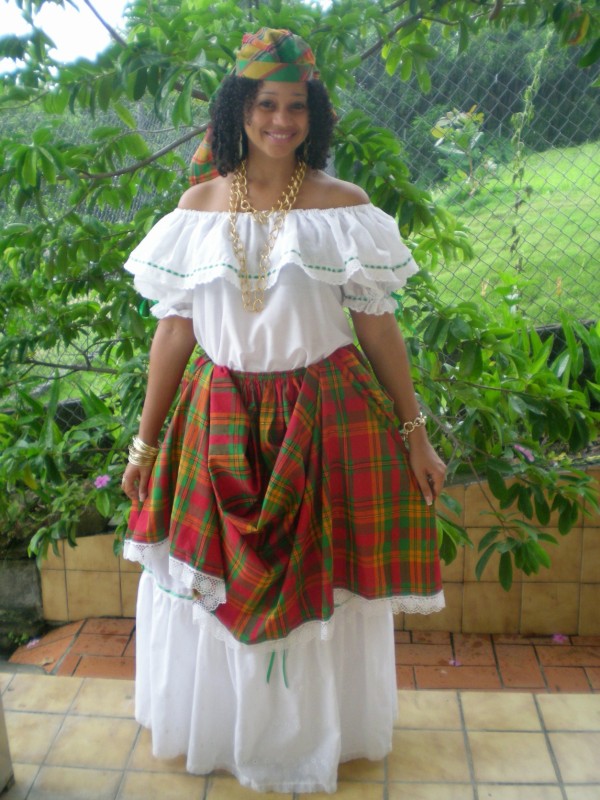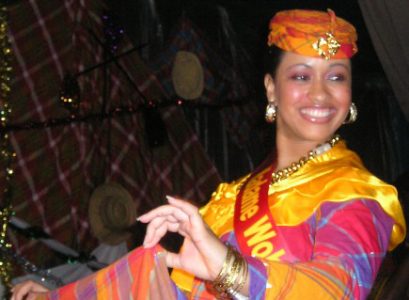Well I started with our national wear, because as I teach the students we are of strong African heritage and Africans love colour. Colour played an important part in the choosing of the materials of our national wear.
Now we have what we call the Madras which is Indian cloth but what we have today is a reminder of what the Europeans wore, because we can still feel the presence of the French when we use the different headpieces that we wear it reflects the French society and in the wearing of the male national costume you can strongly see the English presence.
So what we wear now still reminds us of the English part of our heritage; the white long sleeve shirts that the men wear, the sash which is worn around the waist and is always red in colour, red satin, again coming straight from the London influence, because they [enslaved Africans] just copied from the master. So there were certain things that just stayed and there were some changes and modifications made along the way, but this red sash has remained, the white long sleeve shirt has remained, and the long black pants have remained, also you must wear black formal shoes.
So with the men’s costume now where the African Influence came in was with the use of colour which is where they starting using the Madras material. This material was worn alongside the base colours of the white black and red and bought and added colourful dimension to the men’s national wear.

The Madras material is worn in the form of a waistcoat which we call a Gillette and we also use it as a shoulder band worn across the body from one shoulder to the opposite waist and sometimes a cummerbund is used. Now sometimes the men wear a Kofi which is a small cap with the peak just the rounded part and again [the name] is a reminder of our African origin and the Kofi is made in the Madras.
The Kofi is usually worn for ceremonial purposes especially when the males go as far as adapting a coat they can throw over their white sleeves. So now if you can visualise a man dressed in his full ceremonial dress he has his Kofi, his jacket, tie and waistcoat all made of Madras so you see we use a lot of Madras during these times and this is to emphasise the Africanness in our national wear.
Now with the female we have two outfits. The young people tend to wear what we call the Jip which is a younger version to what we call the Wob Dwiyet which is what we call the traditional wear. Now the Wob Dwiyet came down through the ages and it reminds you perhaps of what Cinderella would wear to the ball. It is noticeable when you look at the slim fit of the waist and the way material has been gathered [in the skirt], if you look at the long sleeves, the use of the scarf, the use of lace and the folds in the dress. To carry this dress beautifully one has to pick it up in a certain way and tuck it into the waist band so that the full effect and regal look of the Wob Dwiyet is achieved.

So within the Wob Dwiyet we use the Madras material and it is a big dress which also uses a lot of lace. The way it is sewn is very delicate and it is a very expensive dress to make because it takes a lot of time and a lot of Material, if you want a good Wob Dwiyet you need about 8 yards (5 metres) of material! This is just for the outer dress because then it has to be lined with cotton it really does take a lot of cloth and a lot of time which is why it’s so expensive, you can pay more than $300EC (approximately £75) for one Wob Dwiyet, this is not for the whole outfit this is just the dress.
Then you have to finish the ensemble with a Tete Case which is a flat headpiece and that Tete Case and even the Dwiyet used to be worn by only married women in the past, it was a status symbol and the headpiece would have one peak which meant the woman was married/ taken this headpiece was only worn with the Wob Dwiyet.. However the Tete Anle, Tete meaning head and Anle meaning in the air, which is worn with the Jip by the younger people has different meanings; one peak means the young woman is aavilable, two peaks means they are spoken for but the man can still try, three peak means the young womans heart is taken and four peaks means there is room for whoever wants to try!
Today we have a national pageant where young girls ages 18 – 25 have to display the Wob Dwiyet in its full regalia and they have to win at the end there must be a winner. There is a talent section and other sections and a spectacular wear section where we encourage the use of local materials or recycled materials.
Now there was a version of the national costume designed for the young people because the Wob Dwiyet was thought to be very hot and very expensive, and the younger people complained that it made them look old or that it was worn by the older people, somewhere along the line a lady called Cece Caulderon developed the Jip outfit as a smaller version of the Wob Dwiyet.
So in the Jip you don’t have the long sleeved dress instead you have a white blouse called a Chemise Décolleté in the sense that it is opened up at the neck with many frills and Broiderie Anglaise like the French.
So now there is this pretty white blouse and a skirt and again we encourage black shoes, never white shoes. The skirt would be made of the same Madras or floral material. We use floral material sometimes because we go back to our Isadore days, Isadore is a feast in Grand Bay, a parochial feast, where there used to be groups of people from the different plantation estates going to church and enjoying themselves and they would dress in a certain way. That was where you would find colour; they would use the floral material even more than the Madras and this again was a representation of the African Heritage. The more colourful you were the better that was for you!

I believe that Africans really love colour and use it to express themselves. Going back to the days when we had to make clothes out of Crocus bags the clothes were drab, uncomfortable and not very cool. So naturally with emancipation and the realisation that we were free people you rebel against doom and gloom. If you see even our houses are colourful! I believe colour makes a significant mark in Dominica, I know it’s the same for the rest of the Caribbean as well but colour is very, very important to us. So this is why we retain this element in our national dress.

